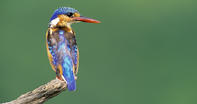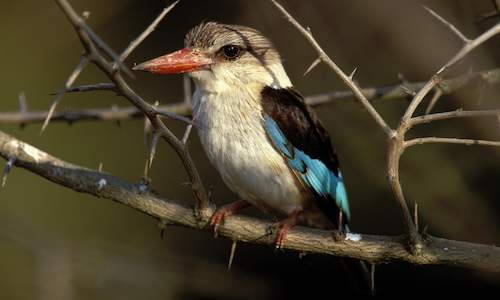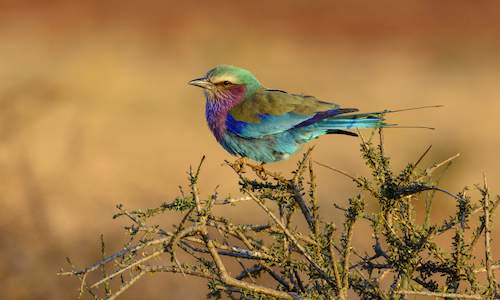
Name
KingfisherFamily
AlcedinidaeAppearance
Kingfishers are some of the most brilliantly coloured birds in South Africa. Many of them have strident voices and dramatic courtship displays. Most species have some blue plumage and many have a red bill. Some kingfishers have adapted well to man’s alteration of their natural habitats and can even be seen in suburban gardens.Kingfisher Diet
Despite their name, not all kingfishers feed on fish and some rarely come near water. Many are carnivorous (feeding on vertebrates such as reptiles, rodents, and birds) and others insectivorous (feeding on insects and other invertebrates).Kingfisher Behaviour
Kingfishers belong to the order Coraciiformes and are related to bee-eaters and rollers. They perch in an upright stance, are large-headed, short-necked and have long stout bills. In flight, kingfishers are speedy and direct, rarely flying above tree level. When hunting for fish, the kingfishers plunge head-first towards the water. They return to a perch to kill and eat their prey. Kingfishers normally sleep in some kind of tunnel or hole.Where they are found
There are 86 kingfisher species throughout the world. Africa has 18 species, ten of which occur in Southern and East Africa.Fishing Kingfishers
In Southern and East Africa, the truly aquatic kingfishers are the tiny Malachite kingfisher, the similar but larger Half-collared kingfisher, the impressive Giant kingfisher and the gregarious pied kingfisher. These four species feed exclusively on fish or other aquatic creatures. The giant kingfisher is particularly fond of river crabs and the malachite eats a high number of tadpoles and dragonfly larvae and is never seen far from water. Accomplished at hovering, the pied kingfisher is able to hunt for fish far from the riverbank, even way out on an open lake or beyond the breakers along the coast.All kingfishers breed in a burrow excavated into the banks of a river. The malachite, half-collared and giant kingfishers are strongly territorial. The pied kingfisher occurs in family groups and a dozen or more may gather to roost in papyrus beds at night. The previous season’s pied kingfisher offspring often help to raise their parents’ next brood. The giant kingfisher, reaching up to 43 cm in length, is the world’s largest kingfisher. Only the laughing kookaburra, a non-aquatic kingfisher of Australia, comes close to this size.
Non-fishing Kingfishers
Six species of African kingfishers feed on insects, arachnids and small vertebrates which are mostly captured after a dive onto dry land. Several of these species are often seen near water as they also breed in sandbanks. The tiny pygmy kingfisher is no taller than a cigarette, but its dazzling ochre and aquamarine plumage makes it a glorious sight. This little bird migrates from the tropics to Southern Africa. They undertake these long journeys after dark and consequently many of these gorgeous kingfishers are killed when flying into glass windows of buildings.Another intra-African migrant is the bold and vociferous woodland kingfisher. With their raucous and repetitive ‘ki...trrrrr’ call they herald the arrival of the summer rains south of the Zambezi. Pairs of these turquoise and blackbirds secure a territory with a suitable tree-hole in which to lay their eggs. They spend several months advertising their presence to competitors with noisy calling bouts and wing-fanning displays. The very similar African mangrove kingfisher breeds in coastal forests (utilising a tree hole). It spends much of its time in mangrove swamps where it preys upon crabs and other crustaceans.
The brown-hooded kingfisher is not a migrant. Although it is a bushveld bird, it is resident in leafy suburbs of South African towns such as Johannesburg, Pretoria, Cape Town, Nelspruit, and Durban. As with other kingfishers, pairs stick together and may hold the same territory for several years. The similar grey-hooded kingfisher is resident in East Africa. Each year between November and April small numbers migrate south of the Zambezi. This insectivorous kingfisher excavates a tunnel nest chamber in a sandbank and is often found near dry watercourses.
The striped kingfisher is the smallest and least colourful of the non-aquatic kingfishers. It is found deep into the central Kalahari and other semi-arid habitats. It is a tree-hole nester and feeds primarily on dwarf geckos, other small reptiles, and insects.
 Kingfishers are conspicuous birds in the Lowveld thanks to their bright colours and noisy, active habits....
Kingfishers are conspicuous birds in the Lowveld thanks to their bright colours and noisy, active habits.... SouthAfrica.co.za provides informative, educational content on many South African bird species that orthologists and bird-watchers would enj...
SouthAfrica.co.za provides informative, educational content on many South African bird species that orthologists and bird-watchers would enj...